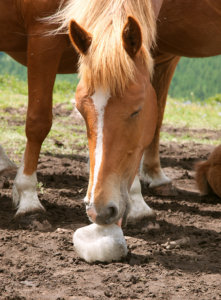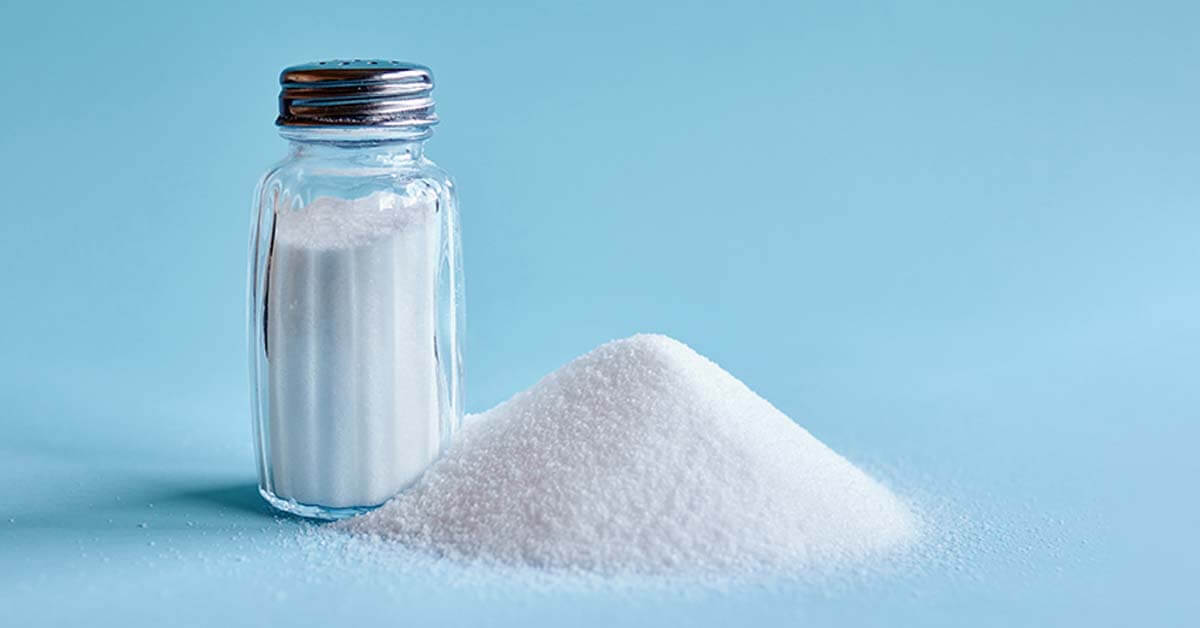The ancient Greeks traded salt for slaves – hence the saying “worth his salt”. Early Roman soldiers were partially paid in salt (salarium argentum) which is where the word “salary” originated.
A severe salt deficiency can cause your horse to die. Napoleon had thousands of soldiers die during his retreat from Moscow when wounds would not heal due to a salt deficiency.
Salt is an essential nutrient – the body needs it but can’t manufacture it. Salt must be provided in the diet.
Salt Consists of Sodium and Chloride (NaCl)
Sodium is an electrolyte. Electrolytes are electrically charged particles called ions. These ions can be lost through sweat. They are necessary for cellular metabolism, a balanced cellular system and the production of energy using calories. Sodium helps maintain hydration and is important to muscle contraction and nerves.
Chloride is an electrolyte. It has a negative charge while sodium has a positive charge. The balance between the two helps maintain healthy blood cells.
Blood is self-regulating (homeostatic). It will go to great lengths to maintain its normal stability – even to the point of robbing nutrients from other organs. If salt is not available through diet, the blood will steal the salt present in urine and sweat. But urine and sweat production cannot be stopped and the blood returns the salt to the kidneys and sweat glands.
The body tries to maintain itself by diluting the urine and sweat with more water to try to keep from robbing the salt from the blood and excreting it. The body’s tissues become dehydrated while the blood tries to maintain its normalcy.
How Much Salt Does a Horse Need?
An average sized horse (1100 pounds), at rest, needs about two ounces of salt per day. Four to five ounces may be needed on hot days and during strenuous exercise when sweat is being produced.
Approximately six teaspoons equals one ounce. There is some salt in commercially produced feeds. If the product is fed according to the feeding directions an ounce of salt per day may be provided by the feed. This is not enough salt.

Blocks or Loose?
Salt must be provided in some form, block or loose. I do not like salt blocks. Blocks of salt were designed for cattle which have rough tongues. That is why many horses bite and destroy the blocks—they are trying to get the needed salt.
I recommend loose white granulated salt – it looks just like table salt. Feed stores offer it in 50-pound bags which are more economical than blocks. You get more salt for your money.
Other Considerations
Horses that are salt starved must be introduced to salt slowly. Salt poisoning is possible if salt is suddenly available. Symptoms of salt poisoning are digestive upset and cramps. Salt is the only mineral which horses know they need. Horses can be deficient in copper or any other mineral and not consume the needed amounts when they are available. But horses will eat salt if their body needs it.
Along with salt, horses need water. Water is the most important nutrient. Increased consumption of salt will increase water intake. A full salt feeder next to a fresh clean bucket of water is required in all horse areas – at all times.
Salt and water…it’s simple and it’s cheap, and your horse is worth it.
The Way of Horses ©2019
* Earn Professional Certification as Horse Trainer, Stable Manager or Riding Instructor. All courses are online. Visit www.equinestudiesinstitute.org for information.

Eleanor Blazer was raised training and caring for horses. She learned to ride and care for the horses her family bought and sold. Many of these horses required improved nutrition when they arrived for training. Eleanor’s experience and research has benefited both horses and horse lovers in the field of equine nutrition. An equine nutrition consultant, based in Bulverde, Texas, she keeps busy doing equine nutrition consultations, conducting seminars, and speaking to youth groups about horse care and nutrition. Eleanor is the author of the syndicated column The Way of Horses. She has more than 20 years experience helping and being a mentor to those wanting to know how to provide the very best care and nutrition for our special friend – the horse.

